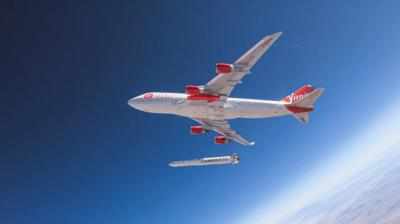Tue, Jun 28, 2022
Virgin Makes Ready for Fifth Go
Virgin Orbit, one of the companies within Richard Branson’s Virgin Group, is making ready to launch its somewhat prosaically named, LaunchOne Rocket. The mission, which will be the vehicle’s fifth, will carry payloads for the United States Space Force’s STP-S28A undertaking, and the United States Department of Defense’s Space Test Program.

Exactly what Space Force and the DOD are up to is anybody’s guess—insomuch as the public receives scant information about classified government orbital payloads. What is known is that the Department of Defense has gathered several satellites from various government agencies to fly in a research and development capacity. Subject satellites will be testing the integration of space-based communications and in-space navigation systems essential to the national security of the United States.
LaunchOne is carried aloft beneath the wing of a specially-modified Boeing 747-400 dubbed Cosmic Girl. Upon reaching an altitude of 35,000-feet, Cosmic Girl’s pilots pitch the aircraft 27° nose-high. Thereafter, controllers aboard the airplane trigger the launch sequence, which begins with the LaunchOne vehicle being released from its mooring-pylon.

Upon release, LaunchOne free-falls for approximately three-seconds before its thrusters ignite and it makes off—BANG! ZOOM!—Jackie Gleason-style. The vehicle accelerates through multiple stages until it achieves breakaway velocity and proceeds ballistically into orbit.
Virgin Orbit’s air-launch protocol offers customers flexibility beyond the pale of conventional pad-launch schemes. Because Cosmic Girl can easily reposition, orbit can be attained from most any point on [over] Earth. Furthermore, inclement surface weather doesn’t hamper Virgin Orbit operations as Cosmic Girl, once airborne, can proceed to calmer skies.
Alas, there is one limitation to which Virgin Orbit’s concept is beholden—weight. Cosmic Girl can carry only so much mass; both jet fuel and rocket fuel are heavy. Ergo, LaunchOne’s maximum payload to low Earth orbit is five-hundred-kilograms—and to sun synchronous orbit, three-hundred-kilograms.
More News
He Attempted To Restart The Engine Three Times. On The Third Restart Attempt, He Noticed That Flames Were Coming Out From The Right Wing Near The Fuel Cap Analysis: The pilot repor>[...]
Make Sure You NEVER Miss A New Story From Aero-News Network Do you ever feel like you never see posts from a certain person or page on Facebook or Instagram? Here’s how you c>[...]
From 2009 (YouTube Edition): Leading Air Show Performers Give Their Best Advice for Newcomers On December 6th through December 9th, the Paris Las Vegas Hotel hosted over 1,500 air >[...]
Aero Linx: NASA ASRS ASRS captures confidential reports, analyzes the resulting aviation safety data, and disseminates vital information to the aviation community. The ASRS is an i>[...]
“For our inaugural Pylon Racing Seminar in Roswell, we were thrilled to certify 60 pilots across our six closed-course pylon race classes. Not only did this year’s PRS >[...]
 NTSB Final Report: Rutan Long-EZ
NTSB Final Report: Rutan Long-EZ ANN FAQ: Turn On Post Notifications
ANN FAQ: Turn On Post Notifications Classic Aero-TV: ICAS Perspectives - Advice for New Air Show Performers
Classic Aero-TV: ICAS Perspectives - Advice for New Air Show Performers ANN's Daily Aero-Linx (06.28.25)
ANN's Daily Aero-Linx (06.28.25) Aero-News: Quote of the Day (06.28.25)
Aero-News: Quote of the Day (06.28.25)




